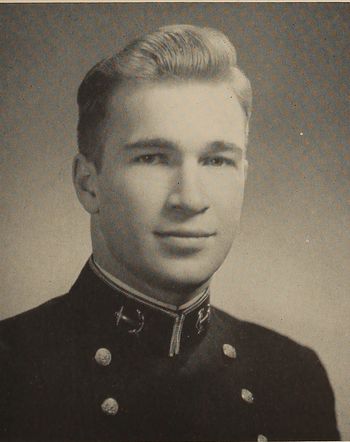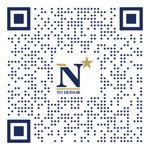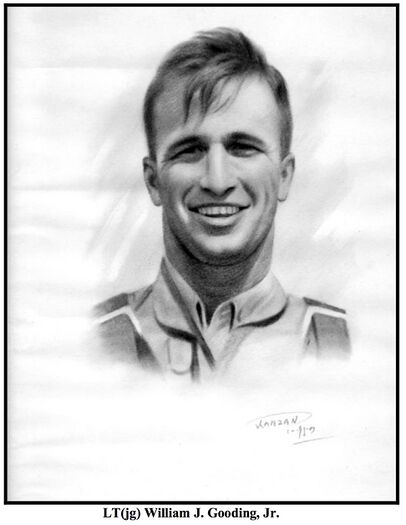WILLIAM J. GOODING, JR., LTJG, USN
William Gooding, Jr. '52
Lucky Bag
From the 1952 Lucky Bag:
William James Gooding, Jr.
Columbia, South Carolina
When "Goods" came from South Carolina, he spent his first year fighting the nicknames of "Rebel" and "Bill." By the end of plebe year, he had learned his right foot from his left and how to present his section in French. Although deep in his Dixie heart was a spark of an old romance, Jim's gregarious personality made him become the date of many a charming lassie. His love for dancing landed him a job on the Brigade Hop Committee for three years and every fall he worked off enough weight to play 150 football. With a minimum of studying and a maximum of good times, Gooding has succeeded in making many friends. The future is indeed bright for "Goods."
He was also a member of the 19th Company staff (2nd set) and received an “E Award.”

William James Gooding, Jr.
Columbia, South Carolina
When "Goods" came from South Carolina, he spent his first year fighting the nicknames of "Rebel" and "Bill." By the end of plebe year, he had learned his right foot from his left and how to present his section in French. Although deep in his Dixie heart was a spark of an old romance, Jim's gregarious personality made him become the date of many a charming lassie. His love for dancing landed him a job on the Brigade Hop Committee for three years and every fall he worked off enough weight to play 150 football. With a minimum of studying and a maximum of good times, Gooding has succeeded in making many friends. The future is indeed bright for "Goods."
He was also a member of the 19th Company staff (2nd set) and received an “E Award.”
Loss
"Jimmy" was lost on August 28, 1956 when the F9F Cougar jet he was piloting crashed on approach to Naval Air Station Olathe, Kansas.
Other Information
From a letter written to Jim's son in 2009:
Mr. W. James Gooding III,
This letter is in response to a request for information on your father from the Naval Academy Class of 1952. Ten of our classmates who knew Jimmy Gooding and went through flight training with him contributed information for this letter. Several past emails addressed to you covered some of Jimmy’s time at the Naval Academy, and in particularly, his playing 150-pound or “sprint” football. That is not repeated here, but I will mention that Jimmy played first-string center on Navy’s 150 pound football team, part of the Eastern Lightweight Football League. That League consisted of Army, Cornell, Navy, Pennsylvania, Princeton, Rutgers Yale and possibly Villanova. Although these guys were lightweights, there was a lot more talent there than people think. THEY COULD REALLY PLAY GREAT FOOTBALL and were league champions in 1946, 1947, 1948, 1950, 1951, 1952, 1953 and numerous other years. In 61 years of competing in the sport, Navy had an impressive 297-62-9 record for an 81.9% winning percentage. Not bad at all!
Your father, William “Jimmy” Gooding, Jr., (better known to us as “Goods”) not only was a classmate of ours at the Naval Academy but was and a warm personal friend. He was a most wonderful person, with a quick wit, magnificent sense of humor and a delightful personality. Jimmy was truly one of a kind. When classmate Jack Sheehan and I (Jerry Zacharias) were roommates on the USS Hornet in Japan in 1955, Jack had a local artist draw the above charcoal sketch of your father from a small snapshot that he had. The drawing is an excellent likeness of Jimmy and is exactly how we all remember him – with a twinkle in his eye, a broad smile on his face and a question on his lips – where is next party going to be? The Sheehan’s would like you to have the original charcoal drawing, which is enclosed.
Upon graduation from the Naval Academy on June 6, 1952, several in the class were selected to remain at the academy to help indoctrinate the new incoming Plebe (freshman) class in seamanship, navigation and close order drill. Jimmy and five of his friends rented a house from one of the academy professors for the summer. These rented houses, located across the river from the academy were known as “Snake Ranches.” They served as a place to eat and sleep as well as to have parties and invite all of the local girls. Jimmy’s Snake Ranch was most successful and they had some VERY large parties. However, one of the neighbors happened to be a retired Navy Rear Admiral and he disliked all of the noise that continued well into the evening hours. Accordingly, he wrote a letter of complaint to the Superintendent of the Naval Academy. By some strange coincidence that Rear Admiral never received a reply from the Superintendent about his noise complaint. We don’t think the fact that Jimmy Gooding worked in the Superintendent’s office had any thing to do with that oversight.
After several months of indoctrinating the new Plebe class, we normally would have been assigned to different ships for several years of sea duty. However, because of the ongoing Korean conflict and the need for pilots, members of the Class of 1952 requesting aviation duty were permitted to proceed from graduation directly to Navy basic flight training in Pensacola, Florida – and so we did en mass.
Navy Basic Flight Training
The first few months at Pensacola consisted of ground school training in the principles of flight, aerology, navigation and other basic aviation related courses. Of course, when not involved in studies or flying you could usually find Jimmy and other members of our class at the piano bar, just across the from the main gate at Pensacola charming the local ladies. Jimmy was particularly good at this.Following ground school Jimmy was sent to nearby NAAS Whiting Field in Milton, Florida to commence the flight phase of training in the propeller driven SNJ shown below. The SNJ was the primary Navy trainer at that time. It was a wonderful experience and every Navy pilot vividly remembers his 13th flight, when the aircraft was landed at one of Pensacola’s many outlying fields, the instructor climbs out of the back seat and the student takes off on his very first solo flight. What a thrill that was!
Jimmy’s early flight training was followed by formation flying, acrobatics, night flying, air-to-air gunnery and carrier landing practice ashore. The final phase of basic flight training was to carrier qualify aboard ship. This consisted of ten or more practice sessions making carrier approaches and landings to a simulated carrier deck ashore. When deemed ready for the ship by our instructors, each pilot took off for the USS Monterey and made six carrier arrested landings followed by a deck take-off. Jimmy completed Basic flight training in December 1953, and was presented his Navy wings several days later by one of the training command Admirals. Then it was off to Corpus Christi, Texas for advanced flight training.
Navy Advanced Flight Training
Every pilot going to advanced training starts with several weeks of instrument flight training (flying under a hood) at the all-weather flight school at Corpus Christi. This provided a solid foundation for flying in bad weather when later assigned to a fleet squadron. Following this training Jimmy and other members of the class reached a decision point of whether they would continue training in propeller aircraft or proceed to jet training. A Marine Major was the Student Control Officer at Jimmy’s unit and had a great deal to say about which route Jimmy would take. He announced to the students that “there are 6 names of 24 in a hat that have the letters VS on them. If you draw one of those six slips, you will be sent to propeller training at NAS Kingsville, TX. The rest of you will get your choice of assignment.” Well, the odds were that if you made an early selection you would have the best chance of getting your choice. So Jimmy and several other members of our class reached into the hat and read their slips – “VS” which meant propeller training. After all the selections had been made it was evident that the Marine Major had lied – EVERYONE pulled VS out of the hat and went into propeller training in the TBM-3E at Kingsville. What a snake!The TBM-3E was a Grumman built, World War II torpedo bomber with a top speed (probably in a vertical dive) of 271 mph. It was better known as the Grumman “Avenger” or affectionately, the “Turkey”, and is shown below. It fought in many campaigns in the later part of WW II and former President George H. W. Bush was a TBM pilot. We always kidded Jimmy that his right arm was bigger than his left one from having to muscle that large airplane around the sky.
Fleet Squadron Assignments
Upon completion of TBM training at Kingsville, Jimmy was assigned to an anti- submarine warfare squadron (VS) at NAS Quonset Point, RI and flew the Grumman S2F “Tracker” shown below. The S2F Tracker was the Navy’s first really capable carrier based anti-submarine warfare aircraft. Jimmy flew the S2F day and night off the Essex class aircraft carriers. (They were the small ones).Jimmy always had his heart set on getting into jets. When an opportunity presented itself that might get him into jets, he jumped at it. Well, one day a Landing Signal Officer from VC-4 was visiting NAS Quonset. Jimmy knew that VC-4 (Composite Squadron 4) flew some of the very latest aircraft. Jimmy so impresses the VC-4 representative that the Commanding Officer of VC-4 requested that Jimmy and three other Class of 52’ pilots be assigned to VC-4 by name. Pretty smooth work Jimmy – only it didn’t fly. The officer and pilot detailer at COMNAVAIRLANT headquarters in Norfolk said, “they have 100 hours in the TBM, they are going to a VS squadron.” Jimmy probably said Oh well, I’ll try again”. And try he did.
Some time near the end of 1955 or the beginning of 1956 at NAS Quonset Point, Jimmy was selected to be the Flag Lieutenant and Aide to the Admiral who was Commander, Fleet Air Quonset Point. (Only the very best are selected to be an Admiral’s Aide).
A man of his word.
One day, while at Quonset Point, Jimmy was informed by the Admiral that he had to attend a meeting in Lisbon, Portugal and Jimmy was to accompany him on the trip. Just outside of Lisbon was the town of Estoril and it happened to have a large and popular casino. So that evening the Admiral and Jimmy headed for the casino to try their luck. As they entered the building the Admiral removed his wallet from his back pocket, extracted $100.00 and gave the wallet to Jimmy with the following instructions “Here is my wallet. Keep it for me and no matter what, don’t give it back to me.” Well, within about ten minutes the Admiral had blown through his $100. So, he found Jimmy at the slot machines and asked him for his wallet. Jimmy refused. Again the Admiral asked Jimmy for his wallet and again Jimmy refused. Now the Admiral was getting as bit irritated and said “if you don’t give me my wallet, I’ll have to court martial you.” Jimmy responded, “well Admiral, you can court martial me, but I’m not giving your wallet back” - man of his word indeed.Being an Admiral’s Aide was a coveted job because on completion of your tour or duty you could usually write your own ticket to wherever you wanted for your next duty station (within reason). Well, apparently Jimmy talked the Admiral into sending him to the Jet Transition Training Unit (JTTU) at NAS Olathe, Kansas. JTTU’s mission was to transition Navy pilots from propeller aircraft to jets. While at JTTU Jimmy checked out in the Grumman F9F-6 “Cougar”, a swept wing, high performance, single-engine fighter.
On August 20, 1956, during a flight in the F9F, Jimmy approached the field for landing and experienced a loss of engine thrust. He activated the ejection seat to leave the aircraft. Back in those days, the minimum recommended safe ejection altitude was 5,000 feet. This was to give the pilot sufficient time to separate from his seat after ejection and to deploy his parachute. Jimmy’s altitude was substantially below 5,000 feet and the parachute did not have time to properly open.
On 8 September 1956, Jimmy was to be “best man” in the wedding of classmate Jack Sheehan and his bride Jean in Kansas City, MO. Unfortunately, Jimmy was lost on the 20th of August. We were devastated to hear of Jimmy’s death, but were privileged to be his shipmates and friends for the years that we knew him.
There are some people in one’s lifetime who are unforgettable -- and Jimmy was one of them. He marched to a different drummer, made our lives brighter with his wit, warmer with his friendship and richer with his free spirit. We will never forget him and we are ardent supporters of the Jimmy Gooding Memorial Trophy that the Class of 1952 is trying to establish in his name.
With heartfelt regards, The Honorable & Mrs. John E. Sheehan and Captain & Mrs. Jerry Zacharias, USN (Ret.). USNA Class of 1952
Jim is buried in South Carolina. In addition to his son, mentioned above, he was survived by his wife, Shirley. (Information from January 1958 issue of Shipmate.)
Photographs

The "category" links below lead to lists of related Honorees; use them to explore further the service and sacrifice of alumni in Memorial Hall.
